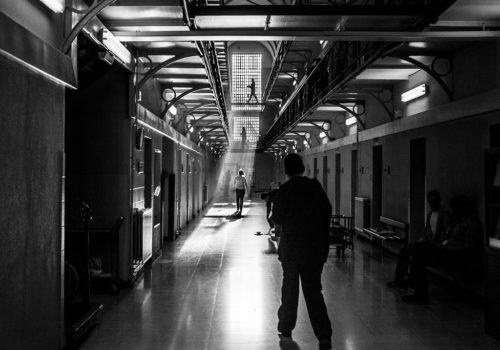“I looked at it as straight as I could.” Fascinated by confinement and the deprivation of liberty, the young photographer from Brussels immersed himself for three years in the universe of the Belgian prison system. His images demonstrate man’s difficulty in managing and containing experiences outside of the norm. He offers dignity to these men and women, confined with their own demons in a harsh universe made of tension and right angles. On a human scale, his gaze, tender almost in spite of itself, shows us the box within the box.
Awarded the Lucas Dolega prize after the fact, his reporting, which is self-financed, is largely published in the press. For the publication of his book, set for the Festival des Rencontres in Arles at the beginning of July 2015, Van Malleghem has appealed to crowdfunding to finance part of the costs of production.
You stayed three days in prison. In what way has this left a mark on you ?
The oppression. The confinement makes you want to beat back the walls. You feel hemmed in. In a cell you hear everything that happens on the other side of the door, but you don’t see anything. You can’t open your window, and in a “modern” prison you can barely see through it. After being locked up twenty minutes, I was surprised to find I was already thinking of breaking out. I think it’s human, normal to want to escape when you’re confined. I understand now, when they say that prisoners are ultraviolent; 8 meters squared with grey walls where you spend hours, days, years. Its almost too much to bear. This is what I make clear in the book : I bring attention to the true face of incarceration, the reality of confinement. Undeniably, crime also makes a part of that reality, but I kept my distance in that regard.
From a box (prison) of boxes (cell), you say. Your feeling is that coming out one is more damaged than going in ?
Certainly. The ties with the family are almost broken. There are some, but they are limited. Psychological assistance is extremely weak for the “normal” inmates, when they should be helped better if the system doesn’t want them to backslide. Thus, the inmates keep their errors in mind, but can’t understand them or correct them; we just lock them in cells with their name and their feeding schedule on the door. On the inside: a T.V., a bed, a dresser. They have the right to “cantine” (the opportunity to buy extra food, cigarettes, etc…) except that it all costs much more for them than for us. If you need to submit a petition to the prison, it’s done by mail… the power of money is tenfold and time management depends on the organization of the prison. Often the inmates can be up to three in the same cell (of 8 meters squared), with only a curtain to hide the toilet.
The full interview is available in the french version of L’Oeil de la Photographie.
http://www.sebastienvanmalleghem.eu
BOOK
« Prisons »
Editions André Frère.
208 pages.
Release during The Rencontre d’Arles 8 – 11 july, 2015
Crouwdfounding :
http://www.kisskissbankbank.com
















